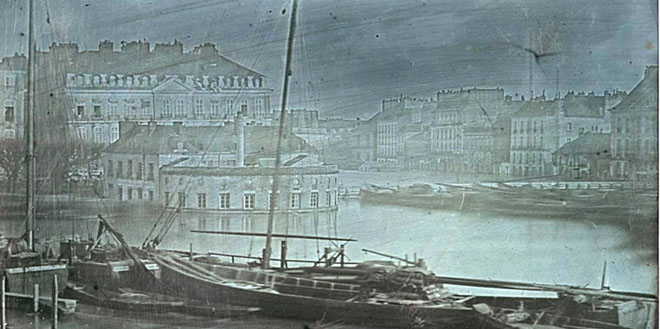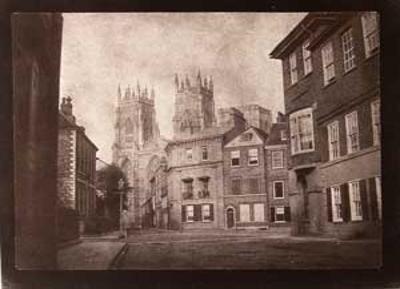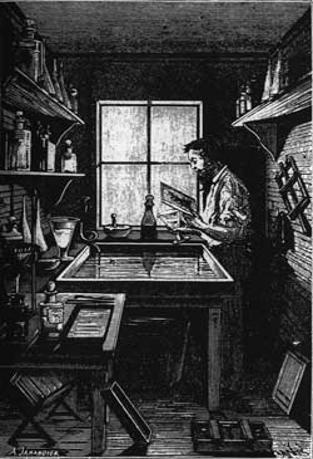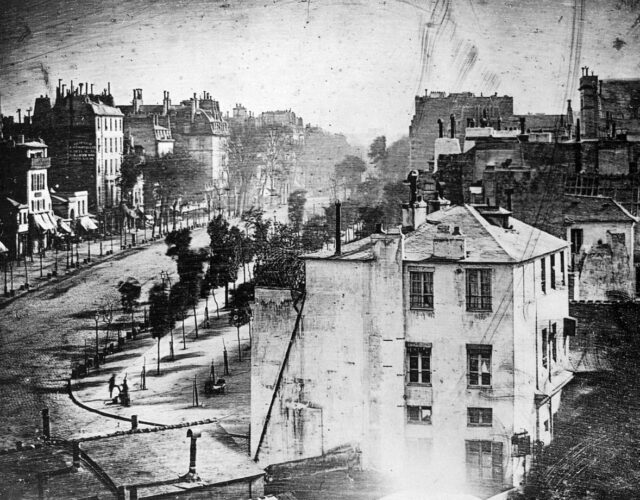All of Europe blazed with rumors. What was the secret of the marvelous images created by an amateur inventor and his showman partner? The appointed day for the revelation was 19 August 1839 at a joint meeting of the Académie des Sciences and the Académie des Beaux-Arts at the Institut de France in Paris. The meeting room quickly filled and an excited crowd spilled out into the corridors, courtyard, and street. An eyewitness reported that “after a long wait, a door opens in the background and the first of the audience to come out rushes into the vestibule. ‘Silver iodide,’ cries one. ‘Quicksilver!’ shouts another, while a third maintains that hyposulfite of soda is the name of the secret substance.”

Daguerreotype of the 1843 Nantes flood by an unknown photographer.
From its beginnings in the 19th century, photography was a curious hybrid. Practiced by amateurs and professionals (male and female alike), the new form of picture making combined art and science, optics and chemistry, and handcraft and industry in unexpected and unprecedented ways. Like the railroad and the telegraph, photography was a modern technological innovation, a product of the Industrial Revolution. But it also had an aura of wonder and mystery: the chemical activity that made an amazingly detailed image appear on a metal plate or a piece of paper seemed almost magical. How could silver and sunlight alone produce such “divine perfection,” as one critic described it?
Light and Lenses
The optical basis for photography is relatively simple. Since ancient times people have observed that light passing through a small hole or lens into a darkened room projects an upside-down image on the opposite wall, just as it does on the retina of the eye. By the 17th century this phenomenon became the basis of a portable artist’s tool known as the camera obscura (Latin for “dark room”). A wooden box was fitted with a lens for gathering light and sharpening the image, which was reflected onto frosted glass on top of the box and traced by an artist. The camera lucida, or “light room,” was a related apparatus—a multisided prism mounted on a vertical rod attached to a drawing board. When an artist peered through the prism, the image appeared to be projected on the paper, where it could be traced.
Such mechanical aids were no substitute for artistic skill. William Henry Fox Talbot, an English gentleman-scholar vacationing near Lake Como in Italy in 1833, attempted to use a camera lucida to draw the scenery but met with little success. As he later recalled, “When the eye was removed from the prism—in which all looked beautiful—I found that the faithless pencil had only left traces on the paper melancholy to behold.” He mused, “How charming it would be if it were possible to cause these natural images to imprint themselves durably, and remain fixed upon the paper!”
Shadows in Silver
Chemistry, it seemed, could provide an answer to this dilemma. Scholars had known for centuries that certain compounds, most notably natural silver salts, darkened when exposed to the sun. In the 1720s German physicist and medical professor Johann Heinrich Schulze baked silver nitrate in an oven to show that light, not heat, caused this discoloration. Schulze also put stencils of texts on glass jars filled with a mixture of chalk and silver nitrate. As he explained, “The sun’s rays, where they hit the glass through the cut-out parts of the paper, wrote each word or sentence on the chalk precipitate so exactly and distinctly that many who were curious about the experiment but ignorant of its nature took occasion to attribute the thing to some sort of trick.”
As the study of chemistry developed throughout the 18th century, more pieces of the puzzle came together. Swedish pharmaceutical chemist Carl Wilhelm Scheele, now well-known as one of the codiscoverers of oxygen, examined the properties of silver chloride in the 1770s, recognizing that the reaction taking place in sunlight was a reduction to metallic silver. He also noted that ammonia stabilized darkened silver chloride—an important step toward solving the problem of “fixing” the camera-obscura image. At roughly the same time, Jean Senebier, a Swiss pastor and botanist, experimented widely with the effects of light on living plants, plant products, and other materials. One of these substances was fused silver chloride, called lune cornée, or horn silver. Senebier found that focusing sunlight through a lens sped up the darkening reaction, while filtering it through various materials slowed it down, and that different colored rays of the spectrum worked at different rates.
Schulze had made silver nitrate “write” messages, but decades passed before anyone tried to create an actual picture using light-sensitive chemicals. The English physicist Thomas Wedgwood of the famed ceramics family and the rising young chemist Humphry Davy moved in the same advanced scientific circles. Wedgwood experimented with silver nitrate in the 1790s and perhaps even earlier; Davy published his friend’s results in 1802, adding some of his own observations. As he reported, the first attempts with a camera obscura failed, for the images were too faint to affect the silver nitrate. The two then took another approach, covering a white surface with the compound and placing it behind a painting on glass. Sunlight passing through the glass produced “distinct tints of brown or black, sensibly differing in intensity according to the shades of the picture, and where the light is unaltered, the colour of the nitrate becomes deepest.” Such contact printing of pictures or silhouettes on treated leather or paper was, however, only partially successful. Though an image did form, Wedgwood and Davy were unable to arrest the process, and the surface soon turned dark all over. Varnishing the picture did not help, nor did “repeated washings.” Davy concluded with the hope that further chemical experimentation could make the image permanent, but it would be another quarter-century before this dream was realized.
The First Photographs
In 1807 Frenchman Joseph Nicéphore Niépce, a modest amateur scientist and inventor from an old aristocratic family, devised an early combustion engine called the Pyréolophore with his brother Claude. Around 1816 Niépce began experimenting with printmaking techniques, and by the 1820s he was creating reproductions of prints with a contact printing process he called heliography, or sun writing. Through trial and error Niépce determined that bitumen of Judea, a resinous substance that hardened upon exposure to light, worked best: the bitumen not affected by light was washed away with oil of lavender, and the metal thus exposed was then etched to form a new printing plate. He also used this bitumen on pewter plates, sensitized with iodine gas, to take images using a camera obscura. The world’s first surviving photograph, an indistinct eight-hour exposure of the view from the window of Niépce’s attic workroom, is a heliograph from 1826.
Niépce soon acquired an unlikely collaborator. Louis-Jacques-Mandé Daguerre, born near Paris, was a theatrical artist and relentless self-promoter. In the 1820s he had devised the Diorama, a popular form of entertainment in which the scenery itself became the show. With clever lighting, large-scale backdrops painted on semitransparent gauze seemed to merge into each other, presenting a convincing illusion of day changing into night or of people moving through the scene. Familiar with the camera obscura from his work on these perspective paintings, Daguerre also dreamed of capturing the fleeting images within the box. Like some previous experimenters, he used silver chloride but didn’t have much to show for it. He often visited the Paris shop of Vincent and Charles Chevalier, father and son instrument makers and opticians, to examine new apparatus and lenses. Here, in 1826, he first learned of Niépce, whom the Chevaliers also supplied with optical instruments.
Ever the enthusiast, Daguerre wrote Niépce to ask how far his work had progressed, announcing that “for a long time, I, too, have been seeking the impossible.” Startled by this bold approach from a total stranger, Niépce remained wary for some time. In 1829, however, after prolonged negotiations, the two men entered into a partnership, agreeing to share any profits from the new invention once it had been perfected. Niépce supplied most of the knowledge; Daguerre provided energy and imagination. The two met only once but corresponded frequently, sharing research results. They were experimenting with silver-coated plates treated with iodine when Niépce died of a sudden stroke in July 1833 at age 69. Daguerre continued the work, painstakingly trying different lenses, chemicals, and processes to improve and fix the heliographic image.
From Niépce’s research Daguerre knew that exposure to light sometimes created a latent image: one that did not become visible until treated with more chemicals. Sometime in 1835 he discovered that mercury vapor made this latent image appear strongly on a copper plate coated with a thin silver layer, but it took him two more years to fix such images permanently with a salt solution. Despite its permanence, the resulting picture had drawbacks. It required a long exposure (several minutes or more), had a fragile surface (needing to be covered with glass and encased), lacked color, and was difficult to see except at certain angles. The image, however, had a remarkable richness of tone and was incredibly sharp and detailed. A magnifying glass revealed wonders that an artist’s pencil could never capture.
Photography Becomes Public
Daguerre, building on Niépce’s work, had finally created a practical picture-making technique, which he named after himself—much to the surprise of Niépce’s son and heir, Isidore. Daguerre planned to profit from the daguerreotype, but events soon took a different turn, thanks to an unusual man. François-Jean-Dominique Arago began his career as a geographical surveyor but then became involved in scientific studies of magnetism and light. Elected to the Académie des Sciences at the young age of 23, Arago brought his scientific interests into politics when in 1830 he became a member of France’s main legislative body, the Chambre des Députés.
When Daguerre approached a group of prominent scientists in late 1838, seeking subscribers for his invention, Arago quickly realized the potential of the new technique. Such an important innovation, he believed, should not remain in the hands of a few individuals. Instead, Arago planned to persuade the French government to buy the invention from Daguerre and Isidore Niépce, thus making it available to the world. He began his campaign with an announcement to the Académie des Sciences in January 1839, praising the “plates on which the [camera obscura] image is reproduced down to the most minute details with unbelievable exactitude and finesse.”
News of the miraculous pictures spread rapidly, and several people came forward to announce that they had independently developed similar techniques. Among them was William Henry Fox Talbot, the Englishman who had been frustrated by his lack of drawing ability with the camera lucida. Talbot’s interests included mathematics, chemistry, optics, botany, the classics, and archaeology. Working at his ancestral estate, Talbot had devised a process he called “photogenic drawing” in 1834. He coated drawing paper with a solution of salt and then soaked it in silver nitrate or chloride. Placing lace or botanical specimens against the paper, he exposed it to the sun. The resulting silhouetted images were fixed, at least for a short time, with sea salt and potassium iodide.

A Scene in York (York Minster from Lop Lane), salt print from paper negative by William Henry Fox Talbot, ca. 1845.
The next summer Talbot expanded his experiments to include camera-obscura images. Using tiny cameras with large lenses nicknamed “mouse traps,” he succeeded in capturing miniature, negative images of parts of his house. Talbot had abandoned these researches, thinking to perfect them at a later date, but the news of Daguerre’s invention galvanized him. He sent specimens of his work to the Royal Institution in London, wrote to Arago and other French scientists, and had papers read at the Royal Academy describing his process.
By early February 1839 Talbot was corresponding with a friend, noted astronomer Sir John Herschel, who had just begun his own work with camera-obscura images. Herschel coined the term photography, meaning “writing with light,” for the new process. His other major contribution was an improved fixing method, immediately adopted by both Talbot and Daguerre. In his 1839 research notebook Herschel wrote, “Tried hyposulfite of soda to arrest action of light by washing away all the chloride of silver or other silvering salt. Succeeds perfectly.” That compound is now known as sodium thiosulfate, widely called “hypo,” which was used as a fixing agent for many years. By the fall of 1840 Talbot had devised a successful negative-positive paper process, which he dubbed calotype, from the Greek and Latin words for “beautiful image.”
Meanwhile, back in Paris, Arago used his political and scientific influence to press forward with the purchase of Daguerre and Niépce’s process. A fire in March 1839 destroyed the Diorama, Daguerre’s main source of income, and provided a further justification for a financial reward. On or around 1 August, a bill proposing pensions for Daguerre and Isidore Niépce passed into law. The details of the method, however, remained secret until 19 August, when all was revealed to the overflow crowd at the momentous meeting at the Institut de France.
Light Sensation
Marc-Antoine Gaudin, a partner in an optical instrument-making firm, was present that day. Immediately after the event he bought iodine and mercury at a nearby pharmacist’s shop and made a camera obscura from a cardboard box and a spectacle lens. The next morning he iodized a plate, pointed his makeshift instrument outside, waited for 15 minutes, and then vaporized the mercury with a candle flame. The resulting picture was simply a dark silhouette of buildings with the window’s balustrade in the foreground, but Gaudin was thrilled. “Everyone wanted to copy the view offered by his window,” he later wrote, “and very happy was he who at the first attempt obtained a silhouette of roofs against the sky: he was in ecstasies over the stove-pipes; he did not cease to count the tiles on the roofs and the bricks of the chimneys . . . in a word, the poorest picture caused him unutterable joy.” Even the most mundane scene became magical when captured in detail on the daguerreotype’s silvered plate.
Though Gaudin was not a professional scientist or artist, he and many others who rushed to try the new medium possessed a wide range of technical skills. Before industrialization became widespread later in the 19th century, many everyday items and specialized tools were still made by artisans in small- or medium-sized workshops in large cities and towns. Paris was home to hundreds of such workshops, along with thousands of merchants selling all kinds of goods. This ready availability of know-how, tools, and materials enabled the rapid spread of the daguerreotype. Daguerre’s first instructional pamphlet, an instant best-seller, was soon joined by dozens of other publications announcing modifications to the process. An 1842 Paris commercial directory listed nearly two pages of scientific instrument makers (including some who were already specializing in daguerreotype cameras, plates, and other apparatus), in addition to two pages of opticians and spectacle makers. The necessary chemicals—for the most part ordinary (if perhaps noxious) substances, such as silver salts, mercury, and iodine—could be purchased at any pharmacist’s shop or from dozens of purveyors of “chemical products.”
In some ways the daguerreotype was one of the original open-source communication systems, long predating the computer age. Thanks to the foresight of Arago and the French government, the “source code” was freely available. Prominent chemist and physicist Joseph Louis Gay-Lussac had predicted this outcome in 1839: “Possessed by a single person, [the process] would remain stationary for a long time, and perhaps would die away; but being made public, it will thrive and improve through the efforts of all.”

Both daguerreotype and calotype methods of image making were replaced in the 1850s by the wet collodion process.
Within months many improvements were introduced: more sensitive chemicals, better fixing methods, faster lenses, smaller and more portable cameras, streamlined processing techniques. There was one exception to this swift progress: England, where Daguerre had patented his process. This controversial move, which seemed to violate the spirit of the French law granting the daguerreotype to the world, was parallel to Talbot’s own decision to patent his paper calotype process, restricting its commercial use to those who paid a licensing fee. As a result the daguerreotype was relatively uncommon in England, and the calotype process had a limited reach in Great Britain and elsewhere, even though Talbot’s negative-positive method later became the basis of modern photography.
The daguerreotype quickly became a worldwide sensation and was especially popular in the United States. Though French poet and critic Charles Baudelaire condemned “our squalid society” that “rushed . . . to gaze at its trivial image on a scrap of metal,” the new process meant that portraiture was no longer restricted to those wealthy enough to employ their own painter. Now millions of people could cheaply and quickly possess detailed images of themselves and their loved ones.
The reign of the unique silvery image, however, lasted less than two decades. The wet-collodion process introduced in 1851, which used glass negatives and paper prints, combined the sharp detail of the daguerreotype with the reproducibility of the calotype. It soon supplanted both methods and was itself replaced by dry-plate processes, then by film negatives, and eventually by digital imaging. Even today, although digital images are paramount, thousands of photographers have returned to historical methods, creating their own handcrafted daguerreotypes and calotypes. As they watch their pictures emerging into the light, they experience the same sense of wonder as did the first photographers.
The author would like to thank Joseph Rucker for his assistance with this article.




